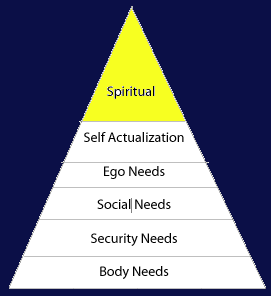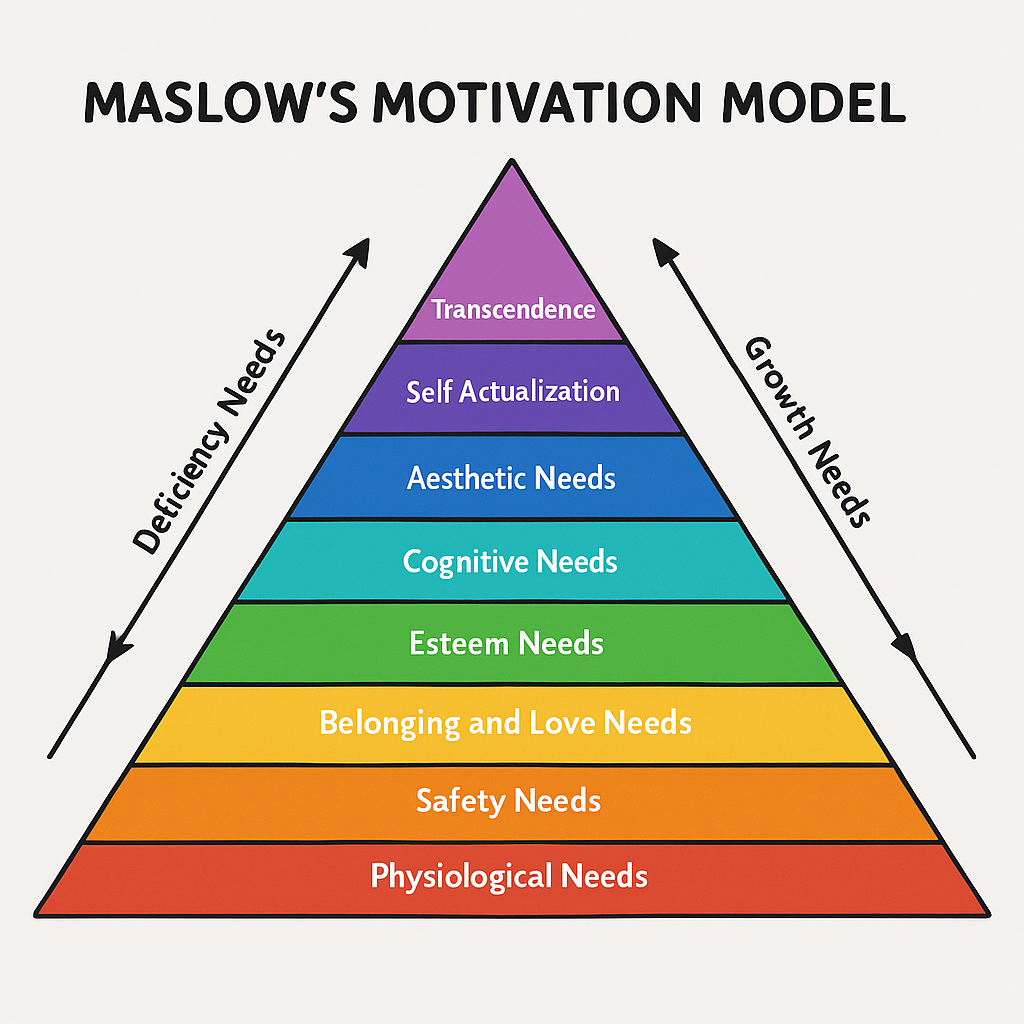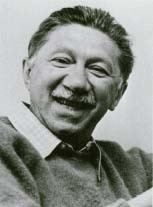Singer and Maslow – Two Visions, One Destination
Abraham Maslow and Michael A. Singer explored human potential from very different directions—Maslow through motivational psychology, and Singer through deep spiritual introspection—but their messages resonate with a shared truth: human growth is not just about fixing what’s broken. It’s about uncovering what’s possible.
Maslow’s Pyramid:
A Journey from Need to Meaning
Abraham Maslow introduced his original 5-layer Hierarchy of Needs in the 1940s as a way to describe how human motivation unfolds from the ground up. Here are those original five layers:
-
Physiological Needs – Food, water, air, sleep, shelter
-
Safety Needs – Personal security, health, financial stability
-
Love and Belonging – Friendship, intimacy, family, social connection
-
Esteem Needs – Self-respect, status, recognition, achievement
-
Self-Actualization – Fulfilling personal potential, creativity, authenticity
I felt that something was missing, so I added Spirituality as a top layer.
Maslow later expanded this into an 8-layer model, which included more nuanced stages of growth and higher states of awareness:
-
Cognitive Needs – Knowledge, understanding, curiosity, learning
-
Aesthetic Needs – Appreciation of beauty, balance, and form
-
Self-Transcendence – Spiritual realization, unity, connection to something greater than the self
This extended model reflects a fuller view of human nature—one that acknowledges our need for knowledge, beauty, and spiritual meaning. Maslow called these higher drives the pursuit of “B-values”: being, truth, simplicity, wholeness, and transcendence.
Chakras and Maslow: Mapping Two Models Together
The chakra system is a map of consciousness from yogic philosophy. It describes seven main energy centers in the body, each associated with specific human experiences and inner functions. When placed next to Maslow’s hierarchy—especially the expanded 8-layer version—the parallels are unmistakable:
-
Root Chakra (Muladhara) ↔ Physiological Needs
Basic survival. Grounding. Physical health and stability. Both are concerned with staying alive. -
Sacral Chakra (Svadhisthana) ↔ Safety and Emotional Security
Comfort, emotional safety, boundaries, and pleasure. When these needs are met, life becomes sustainable. -
Solar Plexus Chakra (Manipura) ↔ Esteem Needs
Personal power, confidence, and identity. Here, the self becomes defined and begins to express its will. -
Heart Chakra (Anahata) ↔ Love and Belonging
Emotional connection, empathy, and trust. Love is both a need and a spiritual force that opens the heart. -
Throat Chakra (Vishuddha) ↔ Cognitive and Esteem Needs
Communication, authenticity, knowledge, and clarity. This is where we learn to speak our truth. -
Third Eye Chakra (Ajna) ↔ Aesthetic and Self-Actualization Needs
Insight, vision, and creativity. The inner world becomes vivid and aligned with purpose and beauty. -
Crown Chakra (Sahasrara) ↔ Self-Transcendence
Spiritual connection, divine unity, and inner stillness. This is the realm where ego dissolves and awareness expands.
Michael A. Singer: From Clinging to Inner Freedom
Michael A. Singer presents something radically different—not a hierarchy, but a complete reorientation of identity. Singer teaches that we are not our thoughts, our emotions, or our story. We are the one who observes.
Instead of climbing toward wholeness, Singer shows us how to surrender what blocks it.
The key is not acquisition, but release. Energy naturally wants to flow up through us—what blocks it is our resistance, our clinging, our fear.
This aligns beautifully with the chakra view. When our inner energies are blocked (what yoga calls samskaras), we feel stuck, anxious, or reactive. But when we relax into awareness and let go, these blockages release—and the energy rises. We become free, open, and filled with light.
While Maslow guides us through development, Singer gives us the tools of liberation: meditation, surrender, present-moment awareness, and the realization that freedom is already here, waiting to be noticed.
A Spiritual Need Maslow Touched, Singer Embraced
Maslow didn’t always talk about God or spiritual surrender. But later in life, he opened to the idea of self-transcendence—a level where the individual self gives way to something far greater. This, I believe, is the need that exists beyond all others. For some people, it remains hidden. For others, it becomes the deepest longing.
And this is where I personally expand Maslow’s vision. I believe there is a ninth level—what I simply call the Spiritual Level. It’s the need to feel close to God, to act in harmony with His will, and to transcend the fear of death with an awareness of eternal truth.
Unlike other levels, this need doesn’t always follow the hierarchy. A person facing death can either fall into fear—or rise into faith. The Spiritual Level has the power to override even our biological needs.
The Parallelism of Maslow’s Hierarchy of Needs and the Chakra System
Both Abraham Maslow’s Hierarchy of Needs and the ancient Indian system of chakras offer maps of human development—one grounded in Western psychology, the other in Eastern metaphysics. Though arising from different cultural frameworks, they both describe a similar journey: the evolution of the self from survival to transcendence.
Maslow’s pyramid outlines human motivation, starting with the most basic physiological needs and culminating in self-actualization and self-transcendence. The chakra system, rooted in yogic philosophy, describes seven energy centers in the body, each associated with specific psychological and spiritual qualities. When viewed side-by-side, a striking parallel emerges.
-
Physiological Needs ↔ Root Chakra (Muladhara)
Maslow begins with our need for food, water, shelter—survival itself. This mirrors the Root Chakra, located at the base of the spine, which represents grounding, stability, and physical security. If either is unbalanced, anxiety and fear dominate the psyche. Stability here is foundational for higher growth. -
Safety Needs ↔ Sacral Chakra (Svadhisthana)
Once basic survival is ensured, Maslow identifies safety—predictability, health, and protection—as the next priority. The Sacral Chakra governs emotional security, pleasure, and relationships. It allows us to explore comfort, intimacy, and creativity. A stable sacral energy reflects a life where safety and healthy boundaries are present. -
Love and Belonging ↔ Solar Plexus and Heart Chakras (Manipura & Anahata)
Maslow’s third level centers on love, friendship, and community. This overlaps with the Solar Plexus Chakra (confidence, personal power) and the Heart Chakra (compassion, love, connection). In the chakra view, we first develop personal strength (solar plexus) before fully opening the heart to give and receive love. Together, these mirror Maslow’s idea of belonging and acceptance. -
Esteem Needs ↔ Throat Chakra (Vishuddha)
Maslow speaks of esteem as both self-respect and recognition from others. The Throat Chakra governs communication, personal truth, and self-expression. Expressing one’s voice authentically and being acknowledged is essential for both esteem and chakra alignment. Here, we step into our individuality and purpose. -
Self-Actualization ↔ Third Eye Chakra (Ajna)
At this level, Maslow describes the need to fulfill one’s potential, to create, understand, and live authentically. This matches the Third Eye Chakra, the center of insight, vision, and intuition. It represents the awakening of inner wisdom and a shift from external goals to internal realization. -
Self-Transcendence ↔ Crown Chakra (Sahasrara)
Later in his life, Maslow added a final level: self-transcendence—the need to connect to something greater than the self. This perfectly aligns with the Crown Chakra, which represents unity, spiritual consciousness, and a sense of oneness with the universe. At this point, the ego dissolves, and a deeper peace emerges.
I felt that self-transcendence basically meant that you could think for yourself, and that seemed a little lame, so I included Spirituality as the top layer on my web page in 2018. But Maslow beat to to it and in 1966 Maslow expanded his model to 8 layers and gave it a new name. It was described in the his book Religions, Values and Peak Experiences (1966): These models are shown on the top left.



